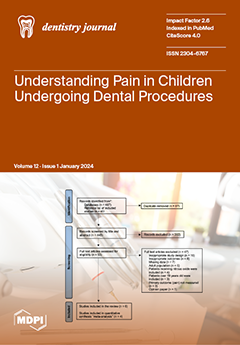Background: Understanding predictors of pain associated with paediatric dental procedures could play an important role in preventing loss of cooperation, which often leads to the procedure having to be performed under general anaesthesia.
Aim: We aimed to identify predictors of intra-operative and post-operative
[...] Read more.
Background: Understanding predictors of pain associated with paediatric dental procedures could play an important role in preventing loss of cooperation, which often leads to the procedure having to be performed under general anaesthesia.
Aim: We aimed to identify predictors of intra-operative and post-operative pain associated with routine dental procedures in children.
Materials and Methods: A systematic review of observational studies was performed using electronic searches on MEDLINE, EMBASE, PsycINFO, Global Health via OVID, PubMed, Scopus, and SciELO. The NIH Quality Assessment Tool for Observational Cohort and Cross-Sectional Studies was used to evaluate the quality of the included studies, which were meta-analysed to estimate the impact of dental procedures and anxiety on children’s pain perception. A meta-regression analysis was also performed to determine the relative effect of predictors on children’s pain perception measured as mean differences on a visual analogue scale (VAS).
Results: The search identified 532 articles; 53 were retrieved for full-text screening; 6 studies were included in the review; and 4 were eligible for the meta-analysis. The meta-analysis showed the types of procedures that predicted intra-operative pain, with dental extractions being the most painful (Mean VAS Difference [MD] 46.51 mm, 95% confidence interval [CI] 40.40 to 52.62 mm). The meta-regression showed that pain scores for dental extractions were significantly higher than polishing (the least painful procedure (reference category)) by VAS MD = 23.80 mm (95% CI 5.13–42.46 mm,
p-value = 0.012). It also showed that highly anxious children reported significantly higher pain scores during dental procedures by a 12.31 mm MD VAS score (95% CI 5.23–19.40 mm,
p-value = 0.001) compared to those with low anxiety levels.
Conclusions: This systematic review demonstrates that the strongest predictors of intra-operative pain associated with paediatric dental procedures are dental extractions followed by drilling. Children with high anxiety also reported more pain for similar procedures. Tailoring interventions to reduce pain associated with paediatric dental procedures should be a priority for future research, as reducing pain can impact compliance and could reduce the need for general anaesthesia in dental treatment.
Full article






